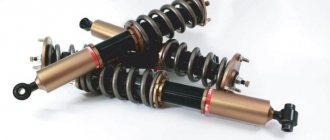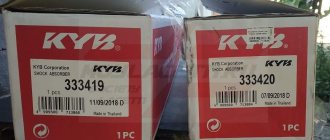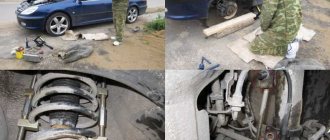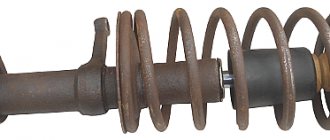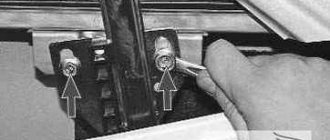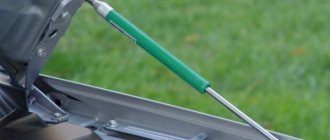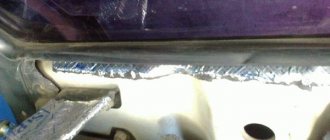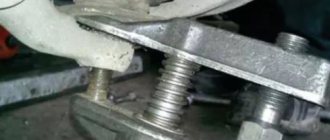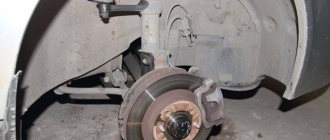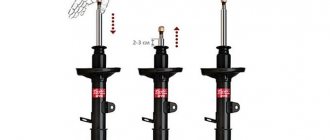Almost every car enthusiast can repair shock absorber struts if he is not afraid of dirty work under the car. At the same time, you will also be able to save a good amount of money. After all, as soon as dull knocks begin to appear in the car’s suspension when driving over holes and potholes, then it’s time to get serious about repairing the shock absorbers.
Each automaker uses its own design developments to dampen vibrations when the vehicle is moving. But shock absorbers are present in almost all modern passenger cars.
The lifespan of a shock absorber is determined by the driving style of the car and the quality of the roads. For example, many 10-year-old cars from Europe with mileage of more than 200 thousand km come to us with “original” shock absorbers. And in our road conditions, a rare suspension part survives up to 100 thousand km.
At the end of this article you will find a visual video tutorial on how to repair the shock absorber strut of a VAZ 2110 car.
Below we will talk about what the main malfunctions of shock absorbers are, and how you can fix them yourself, if you have certain skills, tools and the desire to do this.
Major damage to shock absorber struts
Racks are subject to various breakdowns, among the most common:
- Shock absorber depressurization.
- Damaged rod
- Deformation and wear of the boot and sealing ring.
- Wear of the silent block.
- Broken threaded connection.
- Presence of air in the cylinder
- Eyelet tear
To determine the malfunction, it is necessary to carefully inspect all parts. If oil stains and drips appear, then the shock absorber has undergone depressurization and can no longer cope with its functions - it is preferable to replace it. To better see the shock absorber struts, turn the wheels to the side. You can use a viewing hole or overpass.
To avoid climbing under the car, swing it from the desired side. After rocking, pay attention to the behavior of the car. If it makes more than 2 oscillatory movements before returning to its original position, then the shock absorbers are faulty. And if the car suddenly stops while rocking, then most likely the shock absorber is jammed.
If you hear a knocking sound from the rack, then most likely there is mechanical damage. In this case, it is necessary to carry out diagnostics at a service center on a special stand - this is how the force of each shock absorber is determined.
Frequent malfunctions
The motorist should know the symptoms that will help identify a problem with the struts. Often malfunctions manifest themselves in the following factors:
- the rods in the cylinders move too freely;
- Oil stains are noticeable around the shock absorbers and on their housing;
- when compression or tension occurs, extraneous knocks are heard.
Such symptoms are detected quickly; there is even no need to remove the shock absorbers. During the testing process, the driver presses the car (front or rear wing) several times in the area where the struts are fastened, one at a time. Let's look at the reaction.
How to check shock absorbers
If the suspension is simple (dependent or double wishbone), typical of the Soviet “classics”, then simply sharply press the wing with your hand and release it in order to swing the body by 10-15 cm. If it swings no more than twice, then the test is passed. If not, you will have to change the shock absorber, or even the entire strut (for front-wheel drive cars).
However, for cars with multi-link suspension, such a “number” will not work: it’s all about silent blocks that dampen vibrations. Here you need to contact a technical center where there is a stand to check the device. You can do this yourself, but the result will not be accurate, because you need instruments to measure the force exerted on the product. Remove the suspension element and pull it out by the rod, and then press it in. The tensile force should be significantly greater.
Carrying out dismantling work
To repair or restore the shock absorber struts, you need to remove them from the car. Traditionally, this does not cause difficulties, but in rare cases it is necessary to resort to extreme measures, using gas cutters or grinders.
In less extreme situations, everything can be done with mechanical cleaning of all kinds of contaminants. In most cases, using WD-40 helps. After soaking for half an hour, you can start working.
There are some recommendations that will help you carry out work faster and safer:
- the side of the car where dismantling operations are expected is jacked up and also secured under the bottom and sills (for example, stumps) to protect against accidental shifting;
- comfortable access to the operation area will be provided after removing the wheel from this side;
- It is worth considering that the upper mounting point is located in the trunk or under the hood.
Motorists repairing front-wheel drive cars will have more work. This is due to the specifics of the design. The type of rack used by the automaker also influences the duration and complexity of the operations.
Considerable effort has to be expended when working with collapsible structures. To dismantle it, you have to unscrew the hub fastenings and remove the strut directly with the hub.
Non-separable units are easier to deal with. Before rebuilding the shock absorber, it must be removed. At the bottom it is placed in a cup in which fastening is carried out with one or a pair of bolts. Unscrewing one or two nuts is almost always enough to remove it from the top mount.
It is important to know that in front-wheel drive cars, the struts are most often removed along with the springs.
Repair or replacement? What you can do with your own hands
In fact, this is not such a simple task. Before carrying out work, you should carefully study the material and follow safety precautions. First of all, you need to determine whether your shock absorber is collapsible or not. The monolithic body cannot be repaired; opening it with a grinder and welding it is unacceptable.
We recommend: The engine constantly idles: we carry out diagnostics
If there is a nut or retaining ring where the rod enters the pipe, such a shock absorber strut can be serviced and repaired.
This is what a repairable rack looks like
What's the result?
Taking into account the above information, it becomes clear that repairing car struts with your own hands is possible if necessary. In the case of collapsible shock absorbers, such repairs can be performed independently in a garage by studying the recommendations given in this article.
We also recommend reading the article about which struts are better to choose, oil or gas-oil shock absorbers. From this article you will learn about the advantages and disadvantages of racks of these types, as well as which of them are better in a particular case and why.
If we consider a non-dismountable shock absorber, its repair is often less preferable than replacing the strut. The fact is that the decision to repair such racks may seem more profitable than buying new racks, but that is where the benefits end.
It is actually impossible to obtain any real guarantees for restored shock absorbers, and it is also difficult to determine how they will work (characteristics) and how long they will last (resource) after repair. As a result, the best solution would be to purchase new shock absorbers with a guarantee of quality and safety. The main thing is to buy original products, since there are a large number of low-quality fakes on the market, including shock absorbers of different brands and brands.
DIY shock absorber repair
Almost every car enthusiast can repair shock absorber struts if he is not afraid of dirty work under the car. At the same time, you will also be able to save a good amount of money. After all, as soon as dull knocks begin to appear in the car’s suspension when driving over holes and potholes, then it’s time to get serious about repairing the shock absorbers.
Each automaker uses its own design developments to dampen vibrations when the vehicle is moving. But shock absorbers are present in almost all modern passenger cars.
The lifespan of a shock absorber is determined by the driving style of the car and the quality of the roads. For example, many 10-year-old cars from Europe with mileage of more than 200 thousand km come to us with “original” shock absorbers. And in our road conditions, a rare suspension part survives up to 100 thousand km.
At the end of this article you will find a visual video tutorial on how to repair the shock absorber strut of a VAZ 2110 car.
Below we will talk about what the main malfunctions of shock absorbers are, and how you can fix them yourself, if you have certain skills, tools and the desire to do this.
Why do you need shock absorbers in a car, how they work
Front and rear shock absorbers are damping elements in a car's suspension. Paired with an elastic suspension part, which is a spring or torsion bar, the shock absorber performs several main functions:
- Damping vibrations of wheels and body;
- Maintaining wheel traction with asphalt;
- Ensuring a smooth ride.
To understand how a shock absorber works, you need to understand how it interacts with other suspension components. So, shock absorbers are necessary to reduce the amplitude of body vibrations, which appears as a result of the operation of elastic elements.
The elastic element is a spring, which is attached to the shock absorber. This design is called a rack.
The operating principle is based on hydraulic or gas resistance. Oil is most often used as the working fluid.
Removing shock absorbers
Repair of shock absorber struts begins with their dismantling. Removing shock absorbers usually does not cause problems. Unless the fasteners force the motorist to swear loudly and resort to drastic measures (“grinder” or gas “cutter”).
But most often it is enough to clean the nuts and bolts of sand and dirt, and then treat them with WD-40. After 20-30 minutes you can begin dismantling.
Here are a few points to consider when removing shock absorbers for subsequent repair or replacement:
- Often, the part of the car where the shock absorber is removed has to be lifted using a jack. Be sure to install stops under the threshold or bottom so that the car does not accidentally move during repairs.
- For better access to the lower fastening elements of the shock absorber, you need to remove the corresponding wheel.
- The upper mounting points for the struts in most cars are usually located under the hood and in the trunk.
In front-wheel drive vehicles, removing the strut will require more work. The complexity of the work depends on the type of shock absorber strut.
- Collapsible shock absorber designs are more difficult to dismantle the strut. To remove such a unit, you will have to unscrew the hub nut and remove the strut along with the hub.
- Non-separable shock absorbers have a simpler strut design. At the lowest point, the shock absorber is inserted into the cup, where it is secured with one or two bolts.
The upper mount for both types of struts is usually located under the hood (for front shock absorbers) and in the trunk (for rear shock absorbers). Here you only need to tighten two nuts.
We recommend: Repair of MAN driveshafts
Shock absorber struts on front-wheel drive vehicles are usually removed along with the springs.
Structural features of shock-absorbing struts
Novice motorists mistakenly believe that the main purpose of a shock absorber is to make the ride as comfortable as possible. But, the struts not only absorb all shocks and shocks when overcoming obstacles, they do not allow the car to sway, and the operation of the suspension and braking system depends on their condition.
To understand all the intricacies of restoring the functionality of shock absorbers, you need to know their design and operating features. In modern cars, the most common hydraulic shock absorber is the double-action principle, which consists of the following elements:
- main body with a special lug;
- rod with casing and eye;
- pistons with rings and valve for compression and return;
- seals that retain liquid;
- fastening elements (nuts).
All elements work in an integrated manner to dampen vibrations that occur while the car is moving. If we simplify the operating principle of the system as much as possible, then its operation can be described as follows: a rod with a piston moves inside a cylinder filled with oil. When the piston moves, valves open, allowing liquid to flow into the vacated cavity. Since the pistons operate in a viscous medium, this allows the amplitude of oscillations to be reduced significantly.
The entire structure of the shock absorbers is quite strong and relatively reliable, and the need for repairs, as well as its frequency, depends on the driver. There are several malfunctions that car owners most often encounter.
Stages of shock absorber strut repair
Inspect the removed part for damage. If there are obvious dents and cracks, then there is no point in repairing the rack.
You can restore shock absorber struts yourself in the following ways:
- Completely replace the rod along with the cylinder with a new cartridge.
- Replace individual parts of the rack.
Of course, the first method is much more expensive than the second - approximately 6-10 times more expensive. If you are repairing a strut from a foreign car manufactured later than the 2000s, then it makes sense to buy a new shock absorber, because a new cartridge is almost impossible to find on sale.
To disassemble the part, unscrew the nut and remove the piston. Replace the compression valve by pushing it in by hand. Reinstall the piston and bushing. Pour in any oil - the main thing is that it is clean.
Insert the rod into the cylinder and fill with oil (approximately 220-250 ml). Insert the cylinder slowly, while pulling out the rod so that the oil fluid fills the internal space of the cylinder. Then remove and insert the rod alternately 3-5 times so that the oil is distributed evenly. Then tighten the nut and pump the shock absorber again about 3-5 times.
Bleeding the oil shock absorber
Pumping of gas-oil struts is carried out in the following way:
- Turn the shock absorber with the rod down and push it as hard as possible.
- Hold it in this position for 3-5 seconds.
- Without unclenching, turn the stand over and hold it for another 6-7 seconds until the rest of the air comes out.
- Pull the rod out all the way, and after waiting a couple of seconds, perform the described steps another 5-7 times.
Bleeding the gas shock absorber
- Holding the shock absorber down with the rod, push the rod all the way in and wait 5-7 seconds.
- Turn it over, and after waiting 5-7 seconds, pull the rod out to the end.
- Turn the rack over and do the same steps 3-5 more times.
Repair cost
| Repair of shock absorber with EDC function in shock absorber housing | 7500 |
| Repair of shock absorber with EDC function with remote valve | 7500 — 12500 |
| Repair of MONO shock absorber for AUTO and MOTO equipment | 7500 |
Additional services
| Service name | Cost, rub. |
| Filling the shock absorber with N2 nitrogen | 600 |
| Making a nipple for nitrogen filling | 2500 |
| Manufacturing of shock absorber rod | 2500 |
| Shock absorber rod bumper (polyurethane) | 250 |
| Changing the oil in the MONO shock absorber | 4000 |
| Shock absorber springing without repair | 600 |
Recovery
First, the dismantled device must be washed and then carefully inspected. If there are cracks or jams, repairing the shock absorber makes no sense: it is better to scrap it and buy a new one. The whole body requires further checking: pull the rod up and push it down - if there is play or jamming, replace the spare part. There are two types of shock absorbers, disassembling each of them has its own characteristics:
- double-pipe: pull out the rod completely to gain access to the fastening nut, which can be unscrewed with a special wrench;
- single-pipe: there is a protective cap at the top, which must be knocked down, and then unscrew the fixing nut to remove the rod together with the cylinder or cartridge.
Peculiarities
If the shock absorber is oil, you need to drain the oil from the cylinder by pressing on the valve spring. Then knock down the bushing, remove the rod with the piston, remove the valve from the other side of the cylinder. If the device is gas or has a replaceable cartridge, simply unscrew the fixing nut and install a new one.
Recovery methods
There are two ways: the first involves completely replacing the rod along with the cylinder with a new cartridge, the second involves replacing the parts of the device. It’s worth going into more detail here, because in the first case, the financial costs will be 5-10 times higher (it all depends on the car model). To independently restore the shock absorber with complete disassembly, you must purchase a repair kit.
If you have a foreign car manufactured after 2000, then it is very difficult to find such a set - it is easier to buy a new shock absorber.
To disassemble the product, unscrew the fastening nut and pull out the piston. Further:
- replace the compression valve, which is installed by pressing in by hand;
- install the piston and guide bushing;
- fill in the oil (you can use the old one if it is clean and transparent) - hydraulic fluid for automatic transmission, power steering or the Russian product AZh-12T.
Liquids produced in the West do not have any advantages over materials from the Russian Federation.
Press the rod into the cylinder and fill in 200-250 ml of liquid. Next, slowly insert the cylinder while simultaneously pulling out the rod so that the oil penetrates into the cavity and does not leak out. When the cylinder is fully inserted, pull the rod out and put it back in several times to allow the oil to completely fill the body. Then tighten the nut and pump the shock absorber again 4-5 times.
We recommend: Paint over a scratch on your car with your own hands - from minor defects to deep chips
On a two-pipe device, all of the above restoration procedures must be carried out by putting the upper pipe on the lower one. As you do this, push it down while holding the rod in place. Next you need to bleed the device and tighten the nut.
If the shock absorbers were restored on a MacPherson type front suspension, then the camber and toe will have to be adjusted.
Features of installing shock absorbers on the VAZ2108-15
All operations to restore performance are no different from those described above. But before installation, the shock absorbers must be well pumped (this also applies to new products), otherwise they will not work fully. How to do it?
Bleeding the oil shock absorber
- place the device with the rod down and press the rod until it stops;
- hold the shock absorber in this position for a couple of seconds;
- Without releasing the rod, turn the part over and hold it in a compressed position for 5-6 seconds so that the air comes out;
- extend the rod completely, pause for 2-3 seconds and repeat the operation 5-6 times.
Bleeding the gas shock absorber
- turn the product upside down;
- slowly press the rod in and leave the part in this position for 5-6 seconds;
- turn the product over and hold for 5-6 seconds;
- extend the rod all the way;
- turn the shock absorber over and repeat the procedure 3-4 times.
Useful tips
As it may seem at first glance, you can restore the shock absorber with your own hands even in an ordinary garage. On the one hand, if the shock absorber is collapsible, this is so. However, the vast majority of modern cars use non-removable struts, that is, the manufacturer does not suggest the possibility of repairing them.
Of course, craftsmen restore such parts, but there are no guarantees for restored racks. We also note that the shock absorber on many cars is the basis, that is, a kind of supporting structure of the shock absorber strut as a whole. Of course, over time, the metal of its body accumulates “fatigue.”
It turns out, for example, that the racks traveled about 60-80 thousand km before restoration, then they were repaired, after which it is planned to operate the element for another 50-60 thousand km or more. It is quite obvious that there is no way to guarantee the reliability of such shock absorbers. It often happens that the mounting lugs on shock absorbers come off, the housing cracks, etc.
Otherwise, like any other part, shock absorbers have a certain service life, after which they must be replaced. At the same time, attempts to restore shock absorbers that have exhausted their service life, although they allow you to save money, further driving on such struts poses a certain danger.
We also recommend reading the article on how to check shock absorbers on a car without removing it. In this article, you will learn how to check the struts on your car, as well as what you need to know when checking shock absorbers, what signs and symptoms of malfunction to look out for, etc.
The correct approach is to timely check and replace the struts on the car, and not repair the shock absorber. Also, in order for the new racks to last longer, it is necessary to follow certain rules during the operation of the car:
- avoid making changes to the chassis design;
- carefully move over uneven surfaces;
- do not overload the car;
Also, oil and gas-oil shock absorbers require warming up in winter, when the first few kilometers need to be driven slowly and carefully, avoiding sudden acceleration and braking, driving over bumps at speeds above 30-40 km/h, etc.
When replacing struts, they must be bled. If the shock absorbers have just been installed, you need to do a wheel alignment. At the same time, it is necessary to check the entire suspension, do a full diagnosis of the chassis and eliminate existing faults (if detected).
When the front and rear shock absorber struts need to be checked
Typical malfunctions of this unit are known to everyone:
- Depressurization of the rod seal. Leads to oil leakage from the strut. It can leak at any time. Characteristics change until complete loss of performance.
- The rod moves too freely in the pipe. In fact, the shock absorber strut turns into a guide for the suspension spring. The malfunction is related to the internal valves.
- Play during compression or rebound. Associated with production in the rod or cylinder. The consequences are similar to broken valves. The shock absorber does not perform its function in the car, it knocks, rattles and makes other unpleasant sounds, which is why driving in such a car becomes uncomfortable and dangerous.
- External damage - dents on the body, cracks in the eyelet. They affect the chassis as a whole and can lead to more serious damage.
If any malfunction is detected, it is necessary to remove the strut and free it from the spring. Dismantling is carried out in the garage, without the use of special tools.
Sometimes owners of foreign cars, noticing that their struts have leaked, turn to a service station for diagnostics, where they carry out a test on a stand.
How to restore gas pressure inside the strut (Repair of gas-oil shock absorbers)
- Securely clamp the shock absorber vertically into the yew. Clean the shock absorber thoroughly and blow out the rod inlet hole. Next, disconnect the protective cap of the rod.
- Connect the gas blower to the rod. We pump up the gas to the required rate. Be especially careful during this procedure. You will have to pump more than once until you achieve the desired adjustment effect.
- Lubricate the stem seal and replace the protective cap.
Car owners often argue about what to pump into the shock absorber: compressed air, nitrogen or carbon dioxide. If you are carrying out repairs on your own, in the garage, then there will not be many options. In our case, compressed air will not spoil the condition of the shock absorbers, because this is already a repair, and not the initial production of the strut at the factory.
Repair work with racks
Before disassembling the shock absorber yourself, we recommend studying the theory of the issue. It will help you avoid obvious mistakes and speed up the work process.
For disassembly, you will need some tools, for example, ties, with which you can compress the springs. They are made in the form of power studs with threads on both ends. In this case, on one side there is a left-hand thread, and on the other, a right-hand thread. The end is equipped with a hexagon.
Grips are screwed onto the ends to help effectively hold the coils for compression. The process requires a pair of these pullers to work with each spring. The convergence of the turns occurs after alternate rotation of the pins.
After the spring is tightened to the point of free movement in the rack, unscrew the nut located on top. Then we remove the support bearing and take out the spring.
Car mechanics often notice that the knocking noise occurs due to worn out rubber bumpers . Also, the cause of tight squeaky rotation is wear or breakage of the support bearing.
The collapsible design unwinds thanks to the use of a special key. If this is not available, then you have to use a metal rod and a heavy hammer. After we had to repair the shock absorber, we reassemble it in the reverse order of disassembly.
Only after the top nut has been tightened as much as possible should the spring be slowly released to working condition. In the process, it is necessary that the outer turns fit into the mounting holes, which help to avoid displacement. The next step is to mount the shock absorber in place, install the wheel and lower the car.
How to extend the life of car struts
To extend the service life of the racks, it is recommended to regularly treat the underbody of the car with anti-corrosion compounds. In the cold season, immediately after starting the car, you should not perform any sudden maneuvers or actions.
Sudden acceleration and braking with cold oil in the rack will significantly reduce the service life of parts. Well, one more tip - overcome serious obstacles at low speed.
Source
Required Tools
- A compressor for supplying compressed air or a pump for servicing bicycle shock absorbers.
- Special fitting for injection of compressed air.
Example of a blower fitting - Retaining ring remover.
- Spanners of the appropriate diameter, depending on the design of the rack.
- Workbench and powerful vice.
Attention! It is necessary to take care of safety. The work involves high pressure, so eye and hand protection is required.
Replacing the rod, valves, adjusting the stiffness of shock absorbers
The next malfunction is damage to the rod, seals, and valves inside the strut. There is a certain selection of spare parts on the market for repairing dismountable shock absorbers. In addition, an experienced car enthusiast never throws away old spare parts, but tries to repair them. In addition, you can always extract workable parts from them.
- So, let's disassemble the shock absorber.
Don't forget to wear gloves, the job is dusty
Turning work is usually cheaper than the cost of a new shock absorber
Tip: The entire process of disassembling the shock absorber should be photographed. This will avoid problems during assembly.
Get rid of stains, dirt and dust while disassembling
All parts must be carefully checked
It is recommended to replace the oil seal
After pumping the oil, the rack needs to be pumped as usual
Video: How to repair car MacPherson struts
If you have basic information about how your shock absorbers work, you can save money on replacing them. Most rack models are repairable, and components are either purchased at reasonable prices or made independently.
Source

